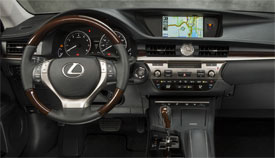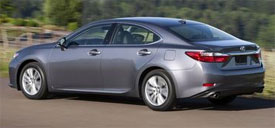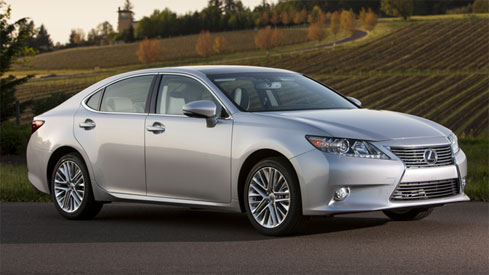2013 Lexus ES
While long the best selling car in the Lexus line-up, the ES has not only had to compete with other entry-level luxury sedans, it’s also had to stay a few notches above the increasingly lavish Toyota Camry on which it was based. Well, now it’s time for an all-new ES, with a new dimension, and some electrifying new hardware. Let’s drive the result!
It’s hard to believe that the 2013 Lexus ES is the 6th generation of the brands entry-level luxury stalwart. And, while it has evolved greatly over the years, never before has it seen such substantial change, as it is now based on the stretched Camry chassis of the upcoming full-size Toyota Avalon. That means a much bigger interior, with over 4-inches of added legroom for the back seat.
 While it’s true the Camry itself has gotten more refined and luxurious over the years, it simply can’t match the level of material quality or options you can get in the ES, like a 15-speaker Mark Levinson audio system, semi-aniline leather on the dash, along with Birdseye Maple or Bamboo wood trim. Navigation is not standard, but if you opt for it, inputs are by a much improved, second generation of Lexus’ remote touch system.
While it’s true the Camry itself has gotten more refined and luxurious over the years, it simply can’t match the level of material quality or options you can get in the ES, like a 15-speaker Mark Levinson audio system, semi-aniline leather on the dash, along with Birdseye Maple or Bamboo wood trim. Navigation is not standard, but if you opt for it, inputs are by a much improved, second generation of Lexus’ remote touch system.
NuLuxe fake leather is standard, but most cars will come fitted with the real thing covering very comfortable seat padding. 10 airbags and Lexus Safety Connect are standard, but not a backup monitor. Hi-tech safety options include Lane Departure Alert, Rear Blind Spot Monitoring, and Rear Cross Traffic Alert. Trunk capacity is 15.2 cubic feet, while the ES hybrid holds 20% less to make room for its battery. That’s right, after recently dropping the HS hybrid from the line-up Lexus has added a hybrid to the ES family, the ES 300h.
Styling is mostly the same for both the standard 350 and the 300h sedans, with a more aggressive look clearly aimed at decreasing the average ES buyer’s age. The front end is wider, nicely incorporating the Lexus family spindle grille, as well as lots of sharp lines. While the new ES is bigger in every dimension, overall length comes in just 1.6-inches longer at 192.7. There are lots of aero aids throughout, including on the door frames and tail lights. The hybrid adds rear spoiler and a hidden exhaust outlet, replacing the ES 350’s dual exhaust setup.
Powering the ES 300h is the Camry’s 2.5-liter I4-based hybrid system that delivers out 200-horsepower through a CVT transmission. The mainstream ES 350 uses a carryover 3.5-liter V6 that sends its 268-horsepower, along with 248 pound feet of torque through a 6-speed automatic. Both feature a Drive Mode selector with Normal, Sport, and Eco modes, with an EV setting for the hybrid.
The ES 350’s Government Fuel Economy Ratings are 21-City and 31-Highway, a slight bump over last year. While The ES 300h hybrid comes in at 40-City and 39-Highway giving the 300h an Energy Impact Score that’s about as good as it gets with annual oil consumption of just 8.2-barrels per year and only 3.7 tons of yearly CO2 emissions.
There’s a reason many of us use “quiet as a Lexus” when describing ultra-quiet cars, and indeed not much has changed there. But what has changed, is the ES350 has gotten a tiny bit more dynamic, but not at the risk of sacrificing any of the silkiness or extreme comfort that the brand is known for. Think smooth and easy, just like Lionel Richie.
 Suspension set-up consists of MacPherson struts up front and dual-link struts in the rear, and the ES remains front wheel drive only. Ride quality is plush, as the ES, unlike the recently revamped GS, makes no pretentions of being a sport sedan; it’s all about wrapping the driver in solid comfort and luxury. Electric Power Steering feels natural and a tad quicker than before. The driving experience of the hybrid is exactly the same, and we put it on par with the Infinti M for power-train smoothness. It’s very pleasant to drive, save for some uncharacteristic- for Lexus-engine noise. Power feels every bit as strong as the V6 too, where a nice hit of electric motor torque gets you up and going.
Suspension set-up consists of MacPherson struts up front and dual-link struts in the rear, and the ES remains front wheel drive only. Ride quality is plush, as the ES, unlike the recently revamped GS, makes no pretentions of being a sport sedan; it’s all about wrapping the driver in solid comfort and luxury. Electric Power Steering feels natural and a tad quicker than before. The driving experience of the hybrid is exactly the same, and we put it on par with the Infinti M for power-train smoothness. It’s very pleasant to drive, save for some uncharacteristic- for Lexus-engine noise. Power feels every bit as strong as the V6 too, where a nice hit of electric motor torque gets you up and going.
Pricing for the 2013 Lexus ES 350 is actually down a bit from last year, however, starting at $36,995 for the ES 350. The ES 300h hybrid goes for $39,745 or $2,750 more than the V6. You can tell designers put a lot of effort into making sure the 2013 Lexus ES lands well ahead of its rivals. It is a much better ES, one that should keep current owners happy, as well as attract new ones. With it no-compromise-on-luxury interior, and the addition of a very well executed hybrid, the new ES is a two-pronged approach that will spark plenty of sales.
Specifications
- Engine: 3.5-liter V6
- Horsepower: 268
- Torque: 248 lb-ft.
- EPA: 21 mpg city/ 31 mpg highway
2024 Polestar 2
More Range And More Power For The Polestar 2
Volvo is well on their way to making the transition to an all-electric brand, but their sister-brand Polestar is already there. Now, we’ve spent lots of time in their all-wheel drive, five-door Polestar 2, having tested it in 2021, and a year later when a two-wheel drive version arrived. But, EV updates are coming quickly. So, let us be your guide for all that’s new with the Polestar 2.
While we are driving more EVs than ever, we’ve also been spending a lot of time recently circling back to ones we’ve previously tested. As in this new era of electrified vehicles, significant updates are arriving quickly, with R&D investments increasing and retrofitting them easier than ever. This is often done through software updates that can even be accomplished over the air. For 2024, the Polestar 2 has indeed gotten some software updates, but some physical ones as well.
Clearly aimed directly at Tesla’s Model 3 when it arrived; the Polestar 2’s build quality was vastly better, but range definitely came up short. So, addressing that was priority No. 1; and for ’24 the Polestar can travel up to 20% farther than before while consuming 9% less energy, and when it comes time to charge it back up, it can do that 34% faster too.
Range in the Single Motor version increases from a max of 270 to 320 miles thanks to a larger 82-kWh battery pack, and that solitary motor now powers the rear wheels, not the front wheels. It’s also bigger, coming in at 220 kW compared to the previous 170 kW front-wheel drive version, going from 231 to 299 horsepower.
Dual Motors keep the same 78-kWh battery, but still sees a boost from 260 to 276 miles and takes advantage of the larger rear motor for a new combined 310-kW output with 421 horsepower. Our test car has the added Performance Pack, which uses an additional 35 kW to deliver 455 horsepower and 546 lb-ft of torque, though max range drops to just 247 miles.
The new battery in rear-drive 2s will also charge faster, now accepting up to 205 kW for an 80% charge in 20 minutes; max for dual-motors stays at 155 kW, which puts an 80% charge at 34 minutes. Using 32 kWh of electricity per 100 miles, the Dual Motor earns a good efficiency rating.
The [Polestar] 2 has always been one of the most enjoyable EVs to drive, even more so now with that additional power coming from the rear motor.
Unfortunately, extremely cold temperatures kept us from seeing that increased range, as we were only on pace for about 194 miles in our test.
The 2 has always been one of the most enjoyable EVs to drive, even more so now with that additional power coming from the rear motor. And especially when equipped with the Performance Pack as it not only includes more power, but adds 20-inch forged wheels, upgraded brakes, and adjustable Ohlins Dual Flow Valve performance dampers. It greatly improves handling prowess without affecting ride quality, and is easily worth the $5,500 charge if you at all enjoy driving.
Even on a 20-degree track day there was plenty of grip through our handling course. No understeer or oversteer, and lots of feedback through the wheel. There was a nice, strong launch off the line that properly planted us firmly in the seat, and rocketed us to 60 in 4.5 seconds. Power delivery stayed pretty intense up until about 80 mph when there was a definite tapering off. Still, it was a 13.4-second quarter-mile at 102 mph; smooth, quiet, and stable the whole way.
When this car debuted, its Google-based infotainment setup was a novelty, but since then, more and more manufacturers are just “Googling it” so it doesn’t seem out of place at all. The wireless phone charger is easy to access, and there’s a great Harmon/Kardon sound system and panoramic sunroof to enhance the in-cabin experience. Exteriors have also been enhanced with a smooth grille insert and new wheel choices.
Hatchback practicality means 14.3 cu-ft of easy to access cargo space with split-folding seatbacks for longer items and expanding the space to 38.7 cu-ft. Plus, there’s even a sizeable storage bin up front under the hood.
Single Motor Polestar 2 pricing now starts at $51,300, with Dual Motors starting at $56,700; topping out at $64,400.
For a car manufacturer that hasn’t even been around for a decade yet, Polestar has kept itself busy, totally transforming their latest model in just a few years, making the 2024 Polestar 2 even more appealing. They are certainly off to a good start, and with a host of Polestars just over the horizon, including some all-important utility vehicles, this star will be shining even brighter.
Specifications
As Tested
- Motor Setup: Dual Motor
- Horsepower: 455
- 0-60 mph: 4.5 seconds
- EPA Range: 247 miles
- Efficiency : 32 kWh / 100 miles
- Battery Size: 78-kWh
- Torque: 546 lb-ft
- 1/4 Mile: 13.4 seconds at 102 mph
- MW Test Loop: ~ 194 miles
- Peak Charging Rate: 155 kW











































